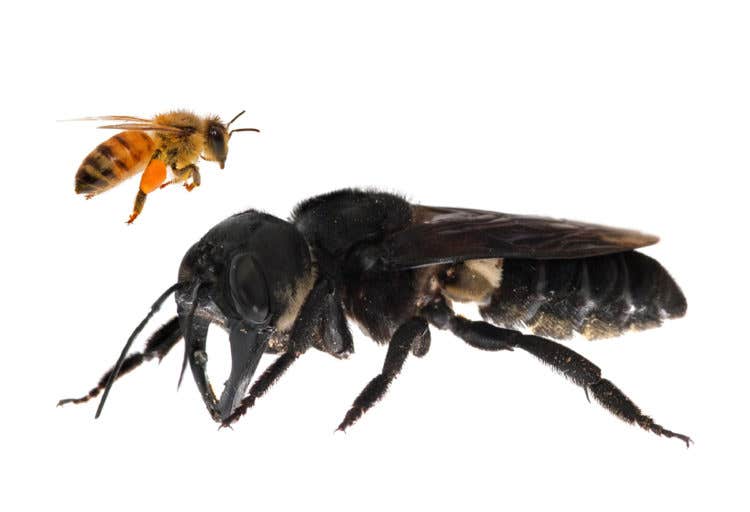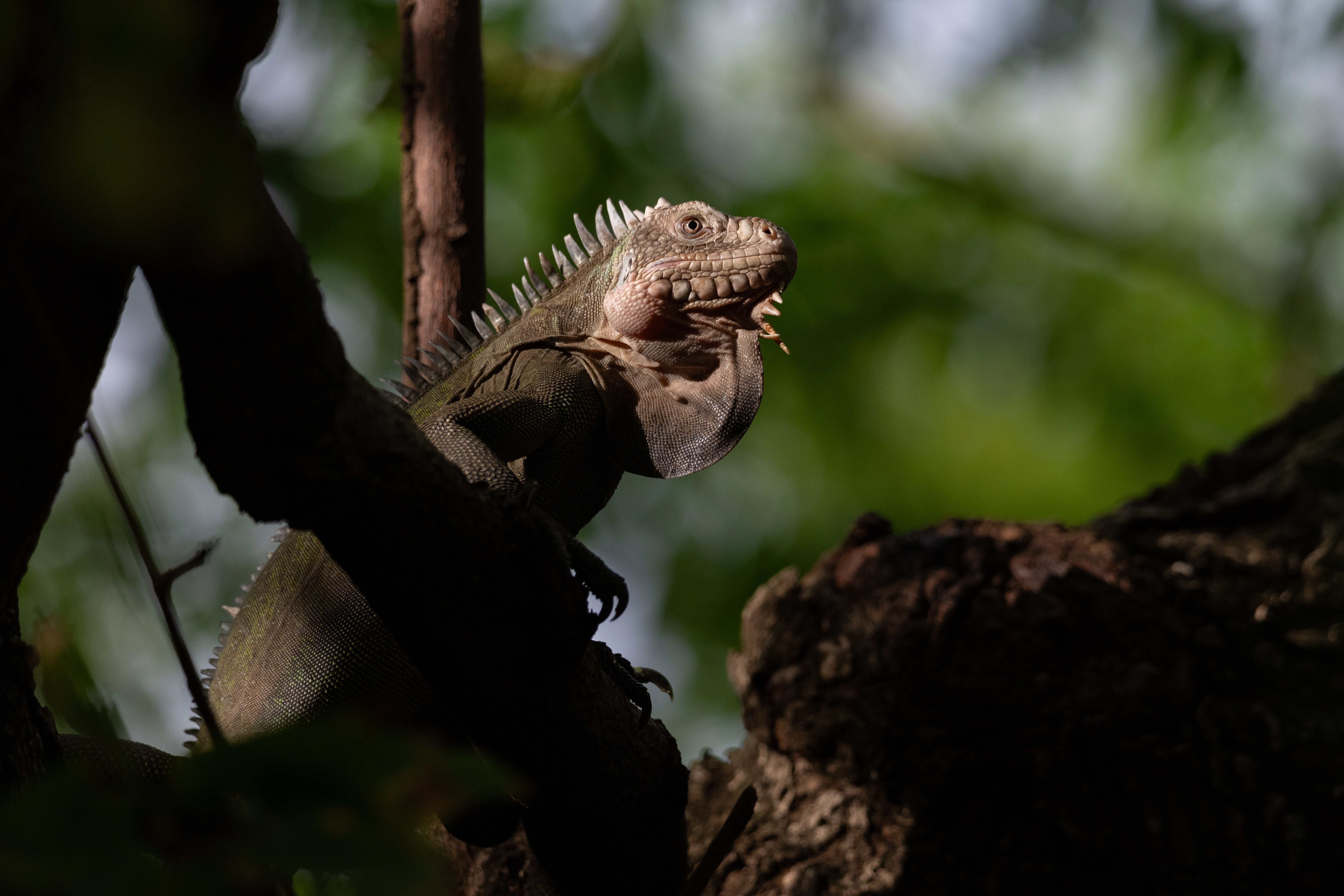Search Team Produces First-ever Live Photos and Video of Indonesia’s Extraordinary Lost Giant Bee Species
 One of the first images of a living Wallace’s giant bee. Megachile pluto is the world’s largest bee, which is approximately 4x times larger than a European honey bee. (Composite). Photo by Clay Bolt.
One of the first images of a living Wallace’s giant bee. Megachile pluto is the world’s largest bee, which is approximately 4x times larger than a European honey bee. (Composite). Photo by Clay Bolt.
For immediate release
February 21, 2019
With an estimated wingspan of two and a half inches, Wallace’s giant bee (Megachile pluto) is the world’s largest bee. Despite its conspicuous size, the bee has been lost to science since 1981. Until now. In January, an independent search team that set out to find and photograph Wallace’s giant bee successfully rediscovered the species—considered the “holy grail” of bees—in the Indonesian islands known as the North Moluccas, resurrecting hope that more of the region’s forests still harbor this species. This is the second rediscovery of one of Global Wildlife Conservation’s top 25 most wanted species under its Search for Lost Species program.
“It was absolutely breathtaking to see this ‘flying bulldog’ of an insect that we weren’t sure existed anymore, to have real proof right there in front of us in the wild,” said Clay Bolt, a natural history photographer specializing in bees, who took the first photos and video of the species alive after spending years researching the right habitat type with trip partner, Eli Wyman. “To actually see how beautiful and big the species is in life, to hear the sound of its giant wings thrumming as it flew past my head, was just incredible. My dream is to now use this rediscovery to elevate this bee to a symbol of conservation in this part of Indonesia, and a point of pride for the locals there.”
The female giant bee makes her nest in active arboreal termite mounds, using her large mandibles to collect sticky tree resin to line the nest and protect it from invading termites. In hot and humid conditions, and sometimes during torrential downpours, the team observed dozens of termite mounds over the course of the search. It wasn’t until the last day of a five-day stop in an area of interest that the team—which also included Simon Robson, honorary professor of biology at the University of Sydney and Central Queensland University in Australia, and Glen Chilton, a professor at Saint Mary’s University in Canada—found a single female Wallace’s giant bee living in an arboreal termites’ nest in a tree, about eight feet off the ground. [READ BOLT’S ACCOUNT OF THE REDISCOVERY]
In 1858, famous British naturalist Alfred Russel Wallace discovered Wallace’s giant bee on his last day exploring the tropical Indonesian island of Bacan. He described the female bee, which is about as long as an adult human’s thumb and about four times larger than a European honeybee, as “a large black wasp-like insect, with immense jaws like a stag-beetle.” The bee wasn’t seen again until 1981, when entomologist Adam Messer rediscovered it on three Indonesian islands and was able to observe some of the species’ behavior, including how it uses its giant mandibles to gather resin and wood for its nests. Since then, other teams have been out looking for the bee, with no luck.
“Messer’s rediscovery gave us some insight, but we still know next to nothing about this extraordinary insect,” said trip member and bee expert Eli Wyman, an entomologist at Princeton University, and formerly at the American Museum of Natural History, which has a single historical specimen of Wallace’s giant bee. “I hope this rediscovery will spark future research that will give us a deeper understanding of the life history of this very unique bee and inform any future efforts to protect it from extinction.”
Although little is known about the bee, the species depends on primary lowland forest for resin and the nests of tree-dwelling termites, Bolt said. In Indonesia, forest destruction for agriculture, however, threatens the habitat for this species and many others. Between 2001 and 2017, Indonesia lost 15 percent of its tree cover, according to Global Forest Watch. The team has already started conversations with Indonesian collaborators to look for Wallace’s giant bee in other locations—with the hope of eventually working together to develop a plan to strengthen conservation measures for the bee.
In addition, because of the bee’s impressive size and seemingly rare status, the species has been a target for wildlife trade collectors. There are currently no legal protections around the trade of Wallace’s giant bee.
“We know that by GWC helping the search team put the news out about this rediscovery could seem like a big risk given the demand, but the reality is that unscrupulous collectors already know that the bee is out there,” said Robin Moore, GWC’s senior director of digital content and media and Search for Lost Species lead. “The bee’s protection moving forward is going to rely first on the appropriate government officials and stakeholders knowing that the bee even exists, and then their willingness to help protect it. By making the bee a world-famous flagship for conservation, we are confident that the species has a brighter future than if we just let it quietly be collected into oblivion.”
A documentary film, In Search of the Giant Bee is now being produced by Vanessa Dylyn of Matter of Fact Media, in association with search team member Glen Chilton.
# # #
Photo: Wallace’s giant bee dwarfs the common honey bee in size. (Composite) Image: © Clay Bolt | claybolt.com
Global Wildlife Conservation
GWC conserves the diversity of life on Earth by safeguarding wildlands, protecting wildlife and supporting guardians. We maximize our impact through scientific research, biodiversity exploration, habitat conservation, protected area management, wildlife crime prevention, endangered species recovery, and conservation leadership cultivation. Learn more at http://globalwildlife.org
The Search for Lost Species
The Search for Lost Species, a Global Wildlife Conservation initiative, is the largest-ever global quest to find and protect species that have not been seen in the wild in decades. In collaboration with more than 100 scientists, GWC has compiled a list of 1,200 species of animals and plants that are missing to science. From this list, GWC has teased the top 25 “most wanted” species in the world. Quirky, charismatic and elusive, these species are global flagships for conservation. Learn more at www.lostspecies.org/
Contact
Lindsay Renick Mayer
Global Wildlife Conservation
512-686-6225
Lindsay is the Director of Media Relations for Re:wild and has a particular interest in leveraging communications to inspire conservation action. Lindsay is passionate about species-based conservation and finding compelling ways to tell stories that demonstrate the value of all of the planet’s critters, big and microscopic.




